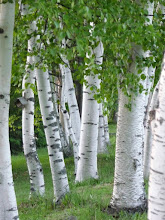Last week I spent two days at the Marshfield School of Weaving, immersed in a workshop given by
Graham Keegan. Graham specializes in dyeing with
persicaria tinctoria, or Japanese indigo and other botanical plants. I had tried to register for this workshop last year, but it was already full, so I got onto the mailing list and landed a spot in this year's workshop as soon as it was posted!
I doubt I will ever master the nuances of indigo dyeing, but experiencing this workshop sure did up my game.
First we did an aqueous extraction, used for protein fibers...
- the leaves of fresh indigo plants, mixed in a blender with water, and strained through a bag made of silk screen fabric.
- the simple vat, with ice cubes added to stop the enzymes.
- check out the gorgeous color oxidizing on a silk scarf!
Then we created a vat for cellulose fibers...
- we filled two big pots (taking advantage of some clever Vermont-style outdoor plumbing) with stems and leaves and hot water, weighted them down and left them to soak overnight.
- we strained the plant bits out the next day and reserved the liquid.
- we added some slaked lime (first dissolved in a bit of water).
- then we poured the reserved liquid back and forth between two pots to oxidize the dye, until it became an opaque green.
- the next step requires another overnight, to allow the sediment to settle to the bottom, the liquid is then poured off and the sediment/paste at the bottom keeps indefinitely. This paste can be used to create a vat whenever it's needed.
We cheated somewhere along there and Graham produced a vat that was ready to go and we did a bit of
itajime shibori, using wooden blocks and metal clamps to compress the fabric, creating the resist.
My hands are still a faint blue, a sweet souvenir of the days spend with fresh indigo. Coming home on the first day, even the clouds were blue up here on the ridge.
The sequence of dyeing, spelled out in one of Graham's banners...
- soak
- wring
- fold
- bind
- dip
- rinse
- oxidize
- balance
- launder
The Marshfield School of Weaving hosts many classes and workshops at their simple and peaceful and lovely farm. You can read all about the place, the people and the skills they share,
here.
My blog post here is not meant to serve as instruction. If you would like to learn more specific information, please be sure to visit your local library for books on dyeing, or prowl the internet, or sign up for a class in your area (even if you have to wait a year to get in!)
I now have a few pieces of fabric, manipulated especially to be used in quilts, which I can add to my naturally dyed stash of supplies. I've also got a lush bed of indigo here at our "bit of earth" to harvest and process in the next few weeks.
Oh, yeah....






























